When you talk about venomous spiders in the United States, the brown recluse spider probably comes to mind. But not all spiders that resemble this dangerous critter are harmful. In fact, there are several spider species that look quite similar — many of them harmless!
In this article, we’re going to introduce you to some spiders that might look like the brown recluse at first glance but are actually not. This way, you’ll be able to identify them correctly and avoid unnecessary panic. But first, let’s discuss the infamous brown recluse!

The Brown Recluse Spider
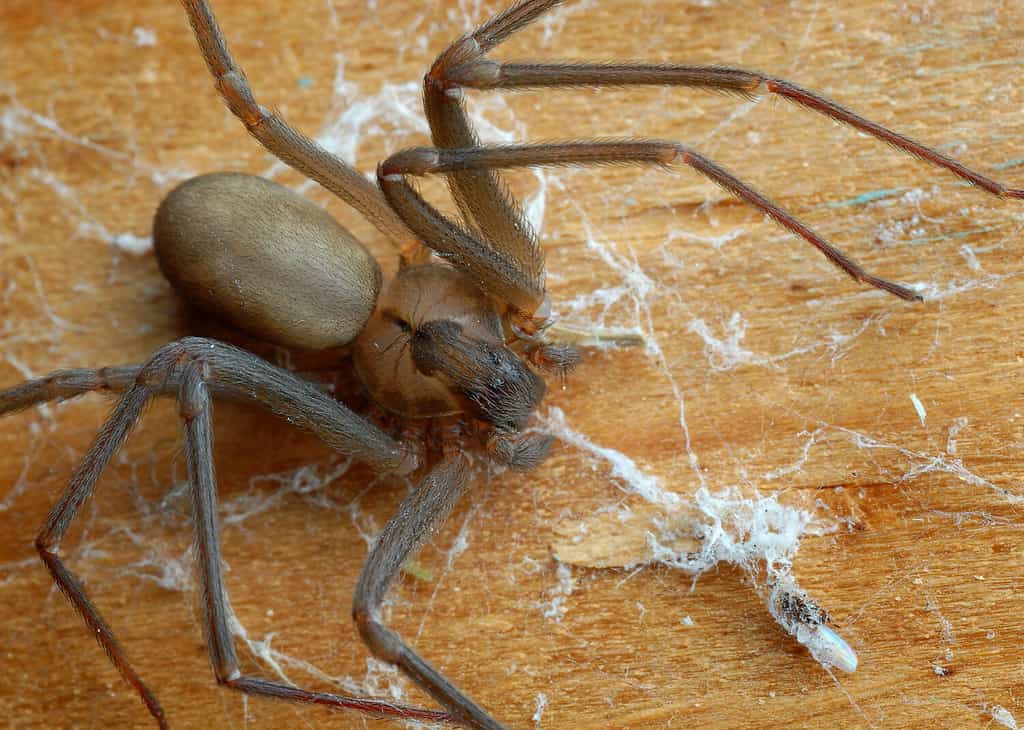
One of the most dangerous spiders in the United States is the brown recluse. This spider possesses venom that can cause a condition called necrosis.
©Miles Boyer/Shutterstock.com
The brown recluse spider is one of the most famous spiders in the United States, thanks to its reputation as a dangerous spider. Unfortunately, this reputation is not founded on false notions. But what does it look like? And exactly how dangerous is it?
As you might be able to deduce from its name, the brown recluse spider is a brown-colored spider. It is around 0.35 inches long and boasts long legs and three pairs of eyes. Unlike many other spiders, like the famous black widow, male and female brown recluse spiders look quite similar. And, most notably, this spider has a distinct violin-shaped marking on its back.
Generally active at night, brown recluse spiders build intricate webs that work as both their own shelter and a trigger system for their prey. With the help of these webs, these spiders can detect nearby prey and hunt them down with ease. Brown recluse spiders are usually carnivorous, with a diet consisting of insects, millipedes, and mites.
In terms of habitat, you can usually find the brown recluse spider beneath rocks or in the bark of dead logs and trees. They can be found in human habitats as well. In our homes, you’re most likely to see a brown recluse on walls and behind or underneath objects. These spiders prefer warm and dry areas.
As you are likely to know already, the brown recluse spider has a potent venom. However, just because you see a brown recluse in your home is no cause for alarm. Thankfully, these spiders are rather shy and are not aggressive when it comes to humans. In fact, they’ll only bite if they feel threatened, so try not to disturb it! The other good news is that brown recluse spiders have small fangs. So, it would be difficult for them to bite through clothing. However, if you are bitten, seek medical attention!
So, what are some of the spiders that look like brown recluses? Here are 8 of them!
8 Spiders That Look Like Brown Recluses
1. Southern House Spider (Kukulcania hibernalis)
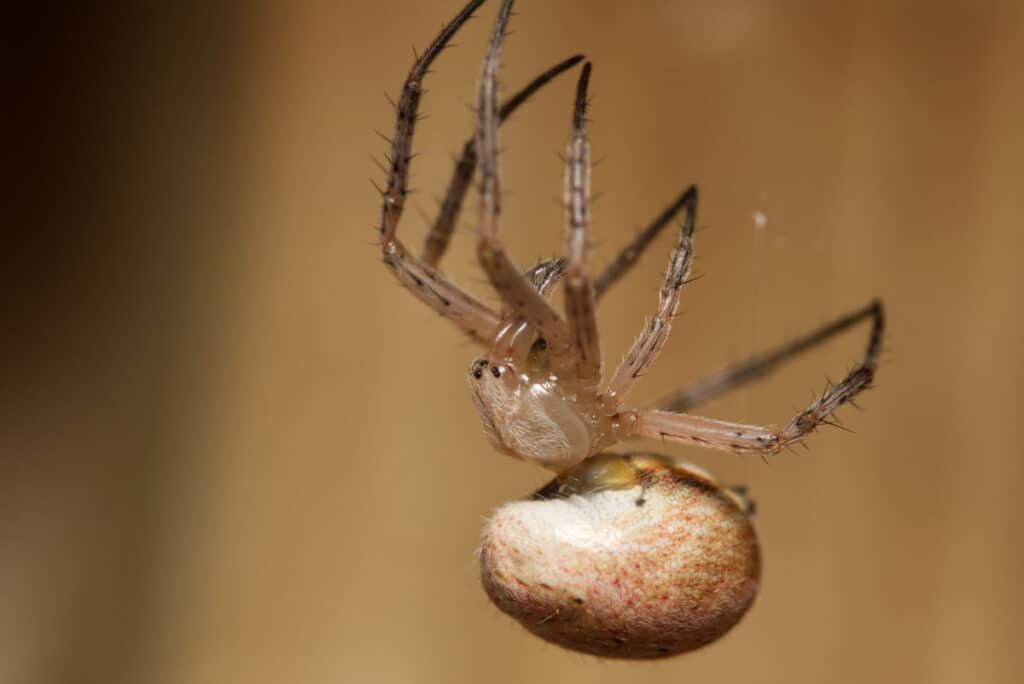
Due to their similar markings and colorings, male southern house spiders often get mistaken for brown recluses.
©Kala Stuwe/Shutterstock.com
In the United States, one of the spiders that gets confused for brown recluse is the southern house spider.
Female southern house spiders sport a dark gray hue, and their overall size, legs included, measures around 2 inches. It’s common for people to notice a resemblance between these females and miniature tarantulas!
Their male counterparts, on the other hand, are frequently confused with brown recluses due to similar shades and physical attributes. However, when properly compared, male southern house spiders are generally bigger, do not feature the recognizable violin mark on their front body section, and possess extended, thin pedipalps.
Mostly found in the southern regions of the United States, these spiders are known to inhabit areas close to human dwellings. They tend to construct their webs within gaps found in home exteriors and farm buildings.
The primary diet of southern house spiders consists of insects. They craft expansive webs at corners of homes or spots that have a higher chance of trapping insects.
Despite their resemblance to the more dangerous recluse spider varieties, southern house spiders pose no real threat to people. They rarely bite, and their venom doesn’t cause any medical concerns.
2. Common House Spider (Parasteatoda tepidariorum)

Another spider that looks like a brown recluse is the common house spider, which has a similar coloring and size. However, this spider is not at all dangerous to humans!
©Sample Stars/Shutterstock.com
From a distance, it’s easy to mistake the common house spider for a brown recluse due to certain similarities such as color and size. Several other aspects link them: nearly identical leg lengths, two segments forming the body with similar dimensions, and a pair of stubby appendages equipped with tiny fangs on the anterior part.
These common house spiders are brown in color, with some featuring white or brown patterns on their back. There is a distinct color differentiation between the males and females. Males have slightly orange-hued legs, while females display a more yellow tint. A standout feature of these spiders is the pronounced dark bands noticeable on their limbs.
These spiders are less than a quarter of an inch in size, with females being larger than males. But males have longer legs.
Common house spiders are highly adaptable and can establish residence in a diverse range of environments. Their habitat spans across gardens and yards to indoor spaces such as basements and attics and even extends to artificial constructions like sheds and barns. Common house spiders feed mostly on various pests commonly found within homes.
Though these spiders carry venom in their fangs, which helps them paralyze their prey, the venom quantity is relatively insignificant to cause harm to humans.
3. Spitting Spider (Scytodes thoracica)
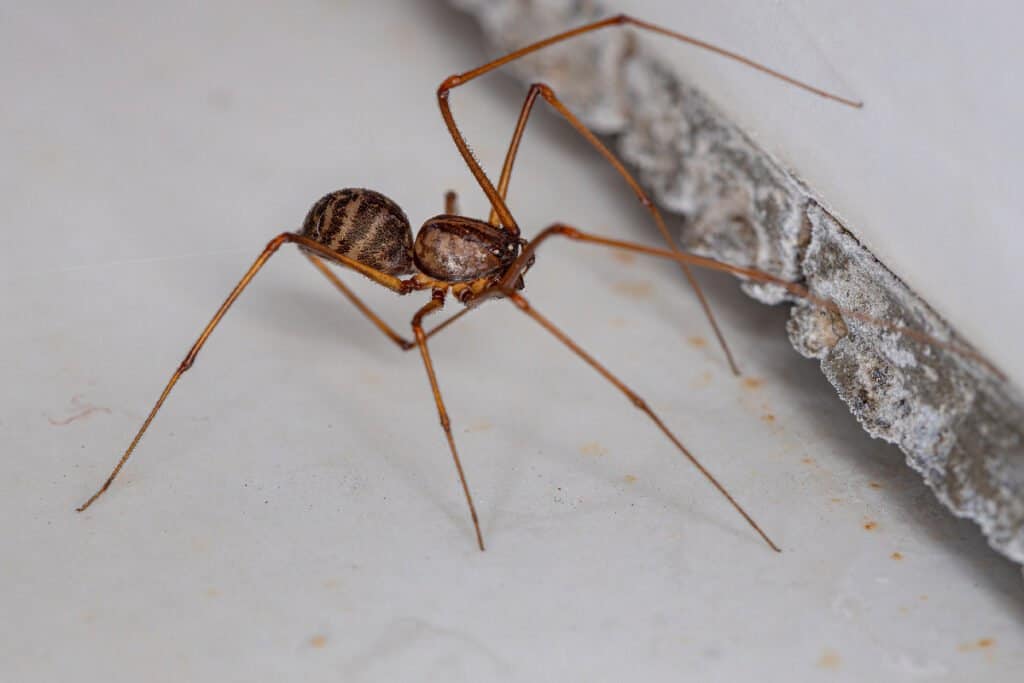
Another brown spider that can be mistaken for the brown recluse is the spitting spider, which has dual-color patterns.
©iStock.com/ViniSouza128
It can be quite easy to confuse a spitting spider with the much-feared brown recluse spider. Both share similar colors, have slender, graceful legs, and feature a set of six eyes instead of the typical eight. To accurately differentiate between the two, closely inspect their legs and body. Spitting spiders sport a dual-color pattern on their limbs and body, in contrast to the one-colored legs of the brown recluse.
The spitting spider is recognizable worldwide, characterized by its orange color adorned with dark designs on both its limbs and torso. It earns its name from its ability to eject a venom-laced silken fluid onto its prey. They are generally small in stature, measuring between 0.12 and 0.24 inches.
They frequently inhabit secluded spots such as cabinets, basements, wardrobes, and shadowy nooks. While some members of this species make webs, the majority are active hunters that adhere to a specific hunting protocol: detecting, ejecting venom, biting, enveloping, and then consuming their prey.
Despite their venomous nature, their fangs are considered to be too small to break human skin, making them non-threatening to people.
4. Arizona Brown Spider (Loxosceles arizonica)

The Arizona brown spider has the nickname “violin” or “fiddle” spider.
©Macrolife/Shutterstock.com
The Arizona brown spider, mainly found in Arizona, is somewhat similar to the more famous brown recluse spider.
However, it’s ever-so-slightly smaller than the brown recluse, measuring about one-third of an inch. It also has a faint, violin-like marking on its head, which is less prominent than that of the brown recluse. This marking gives the Arizona brown spider the nickname “violin” or “fiddle” spider.
These shy spiders usually hide in the debris in the desert or near homes in quieter or outlying regions. They mainly eat ants, particularly the carpenter ants.
Although they aren’t brown recluses, Arizona brown spiders can still bite, and their venom causes similar problems. Their bites can kill the skin cells around the bite area, a condition known as necrosis. In rare cases, their venom might even cause renal failure.
5. Woodlouse Spider (Dysdera crocata)
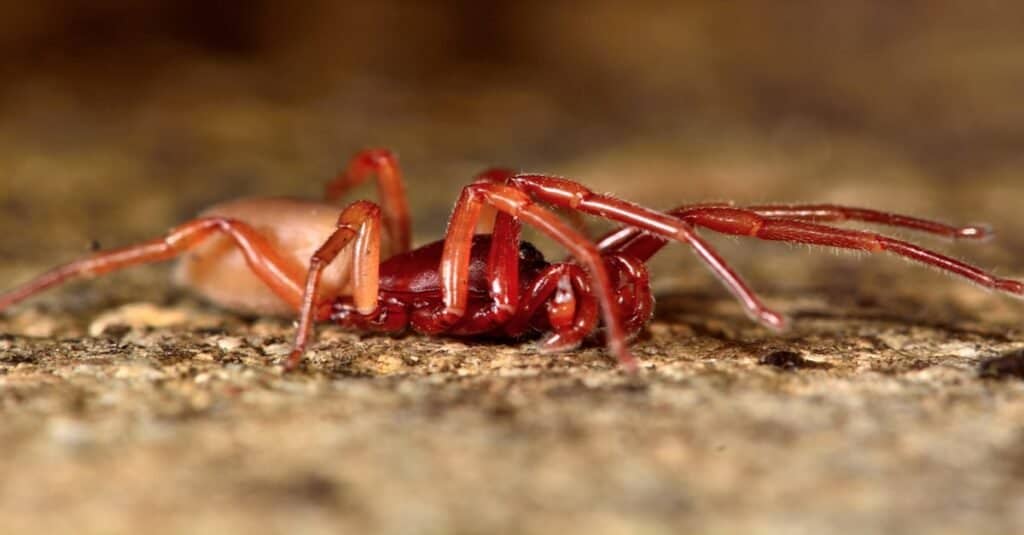
Thanks to their similar coloring and shape, people often confuse
woodlouse
spiders for brown recluse spiders.
©IanRedding/Shutterstock.com
It’s not uncommon for people to mix up woodlouse spiders with brown recluses due to their similar shapes. However, there are several notable differences that make them easy to distinguish. Namely, the woodlouse spider has a unique cream-toned belly, and while their legs are orange-brown, they are not as long as those of the brown recluse. The woodlouse spider showcases a sleek, glossy exterior. Furthermore, their noticeable jaws are what sets them apart from other spiders. Generally, the females grow larger than their male counterparts, with some reaching up to half an inch in size.
Woodlouse spiders usually make their homes in areas concealed by natural elements such as rocks, firewood stacks, mulch, tree bark, and dense vegetation. If they find their way into homes, they tend to settle in lower ground areas or beneath the floorboards in various rooms.
Equipped with strong jaws, these spiders specialize in hunting woodlice, their exclusive prey, capable of penetrating the hard shell that woodlice carries. Rather than building webs, they venture out at night, exploring warm, moist locations in pursuit of wandering woodlice.
Despite their somewhat frightening appearance, characterized by large, prominent fangs, they are less dangerous than they seem. Though they might bite if provoked or handled, their bites are not venomous and don’t pose a serious threat to humans.
6. Hobo Spider (Eratigena agrestis)
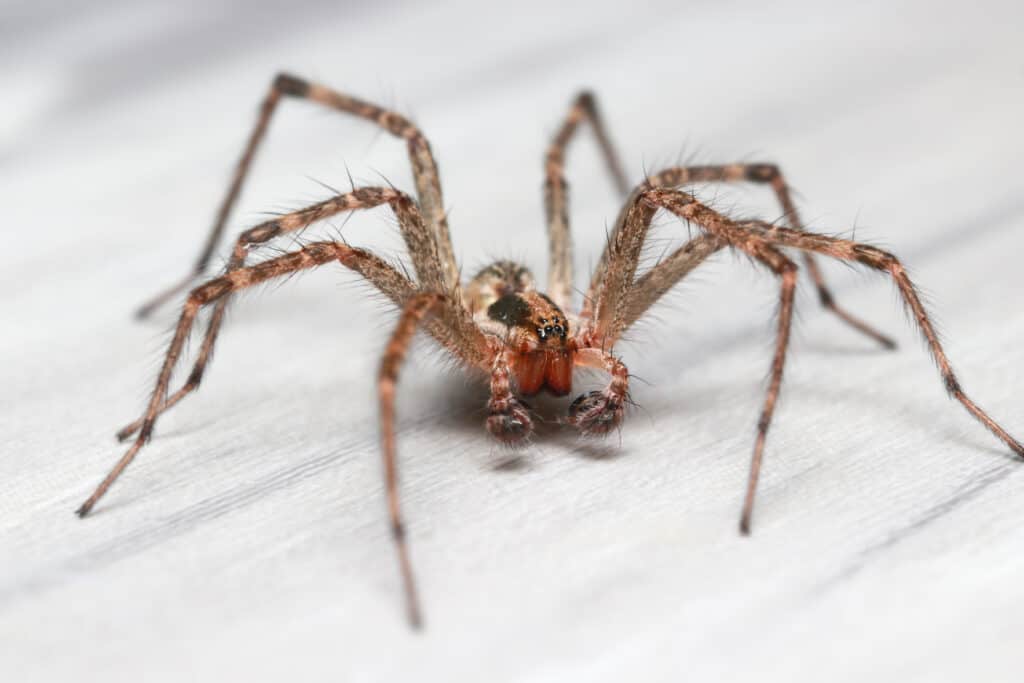
An interesting fact about the hobo spider is that it constructs funnel-like webs in which they wait to ambush unsuspecting prey.
©SNEHIT PHOTO/Shutterstock.com
Hobo spiders have a brownish color and have patterns on their back, a characteristic that often leads to confusion with the brown recluse spider. Sporting a variety of brown tones, hobo spiders feature eight elongated legs and a unique greyish belly adorned with yellow V-shaped patterns. The body of the spider is relatively small, measuring about half an inch, but its legs can extend a considerable distance, spanning from one to two inches.
These spiders tend to occupy areas where they can easily construct tunnels or funnels, utilizing available gaps or hollows for this purpose. Given their limited ability to climb, they mainly stay close to the ground.
A distinctive characteristic of the hobo spider is its knack for crafting funnel-shaped webs that effectively trap insects. They often conceal themselves within these webs, waiting to ambush unsuspecting insects like house flies, cockroaches, and ants that wander too close.
Contrary to widespread belief, hobo spiders are not a significant threat to humans. Their venom isn’t exceptionally harmful, and they don’t exhibit more aggressive behavior or a higher tendency to bite compared to other spider species.
7. Rabid Wolf Spider (Rabidosa rabida)
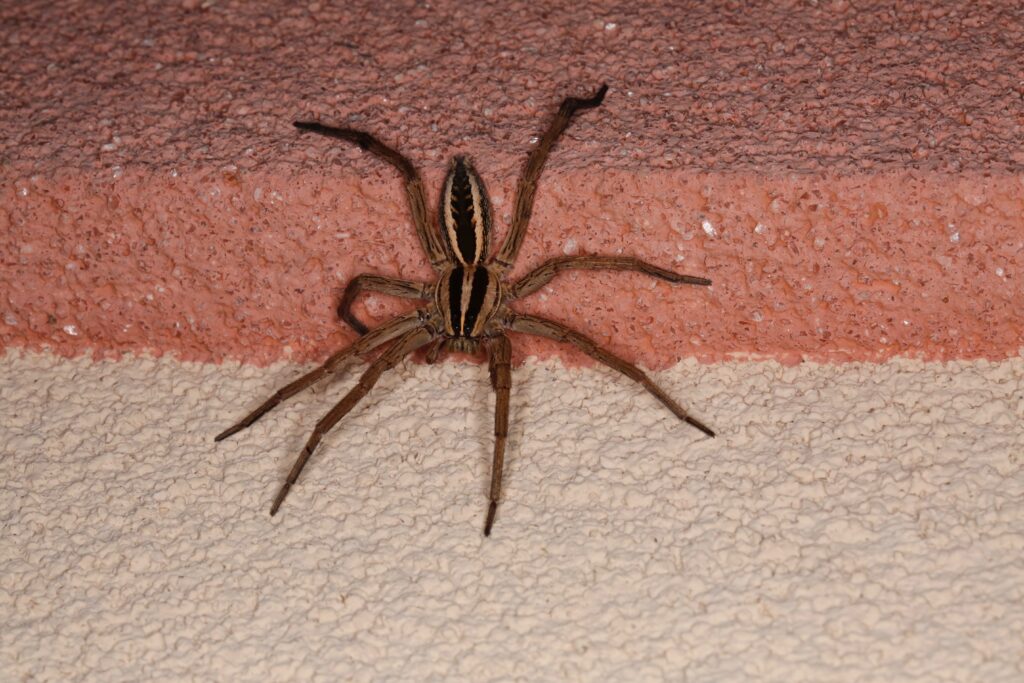
With a similar coloring to brown recluses, rabid wolf spiders may look similar at first glance but they are an entirely different species.
©Cathleen Wake Gorbatenko/Shutterstock.com
Often mistaken for the brown recluse due to their similar coloring, rabid wolf spiders actually have distinctive features that set them apart. Namely, they don’t have the violin-like marking commonly found on brown recluses. Instead, they have banded patterns on their legs and tend to be much bigger in size.
These spiders predominantly have a pale brown color but have unique patterns that help in identification. They display narrow brown streaks along their flanks, coupled with two broad dark lines on their head region and a dark central stripe on their belly. The females are generally larger, their bodies measuring between 0.63 and 0.83 inches, while the males are slightly smaller, ranging from 0.43 to 0.47 inches in size.
Favoring environments like cotton fields and forested regions, they often inhabit holes or accumulate in litter scattered across these areas. Occasionally, you might spot them near water bodies or in extensive burrows concealed by natural debris.
Unlike many spider species, rabid wolf spiders don’t rely on webs to trap their prey. They are agile predators, preferring to actively seek out and pursue their meals, which usually consist of smaller creatures such as crickets, ants, grasshoppers, and even other spiders.
While they may look a bit fierce, rabid wolf spiders are not known to be aggressive, resorting to biting only if they feel cornered and endangered. Although their bites can cause discomfort, they are not venomous or life-threatening, and they don’t transmit any diseases, including rabies.
8. Cellar Spider (Pholcus manueli)
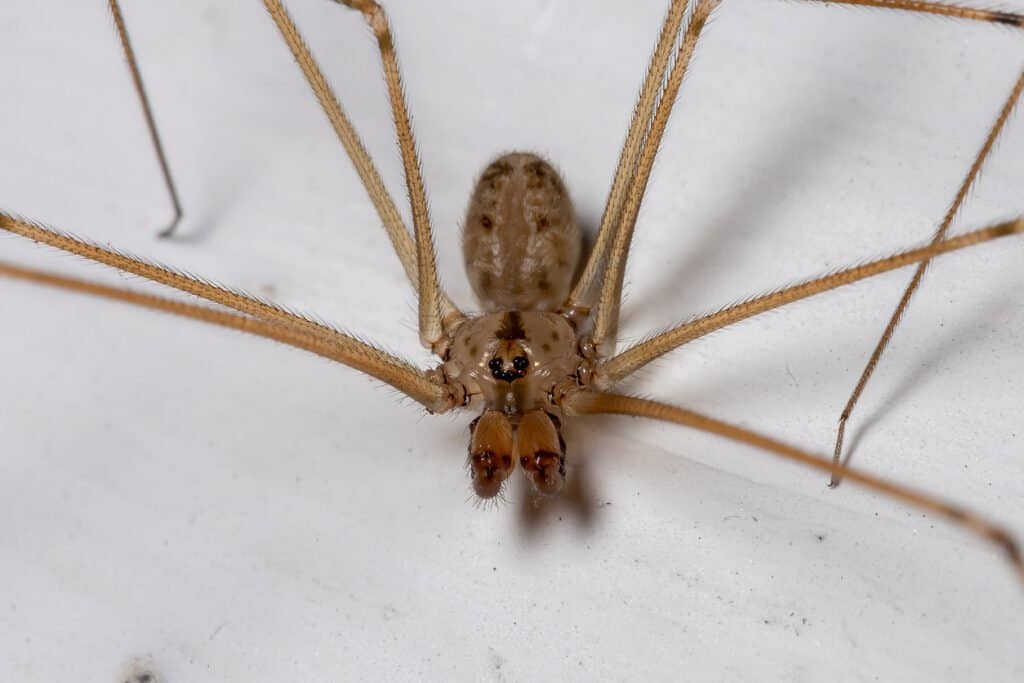
One of the most common spider species you’ll find in a home is the cellar spider, which is often confused for brown recluses.
©iStock.com/ViniSouza128
Cellar spiders share a light brown color and sometimes a dark thorax mark with the brown recluse, which can cause some confusion. However, one glaring difference is the cellar spider’s notably long and slender legs.
These spiders possess elongated, oval bodies with colors ranging from pale yellow to light brown or even gray. The females are typically about 0.25 to 0.31 inches in body size, flaunting front legs that span between 1.75 and 2 inches.
You can usually find these spiders dwelling in dark and secluded places like basements, storage facilities, garages, and caves. They have a penchant for feeding on other small arthropods, including various insects and spiders. Remarkably, they can overpower prey considerably larger than themselves, such as wolf spiders and crane flies. Their appetite for other pests has earned them a level of acceptance in some household basements.
Although cellar spiders do carry venom, they aren’t considered a medical threat because they seldom bite humans. Despite this, there’s a persistent but unfounded rumor that their venom is one of the most lethal in the world.
Summary of Spiders That Look Like Brown Recluses, But Are Not
| Number | Spider | Scientific Name |
|---|---|---|
| 1. | Southern House Spider | Kukulcania hibernalis |
| 2. | Common House Spider | Parasteatoda tepidariorum |
| 3. | Spitting Spider | Scytodes thoracica |
| 4. | Arizona Brown Spider | Loxosceles arizonica |
| 5. | Woodlouse Spider | Dysdera crocata |
| 6. | Hobo Spider | Eratigena agrestis |
| 7. | Rabid Wolf Spider | Rabidosa rabida |
| 8. | Cellar Spider | Pholcus manueli |
The photo featured at the top of this post is © Miles Boyer/Shutterstock.com
Thank you for reading! Have some feedback for us? Contact the AZ Animals editorial team.






